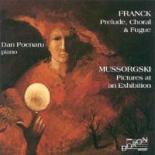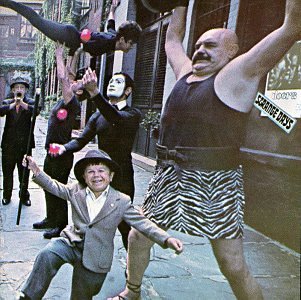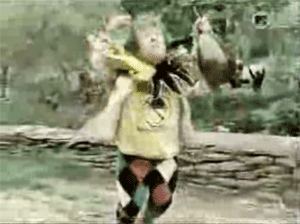... newer stories
Donnerstag, 6. September 2007
A small error

Once again, we are not sorry.
... link (0 Kommentare) ... comment
Donnerstag, 30. August 2007
Weird Al Yankovic: Yoda

I asked him his name and in a raspy voice he said "Yoda"
Y O D A, Yoda
Yo-yo-yo-yo Yoda
—Weird Al Yankovic: Yoda
... link (0 Kommentare) ... comment
Freitag, 24. August 2007
Modest Mussorgski: Gnomus

(Quelle: Wikipedia)
„Gnomus“ ist das erste Bild: Ein Zwerg, der linkisch auf missgestalteten Beinen herumhüpft. Die Musik deutet wilde Sprünge an, innerhalb derer kurz pausiert wird; auch der düster anmutende Mittelteil des Stücks wird von eruptiven Musikmotiven des Gnomus unterbrochen.
(Quelle: Wikipedia)
... link (0 Kommentare) ... comment
Freitag, 17. August 2007
Men Without Hats: Safety Dance
... link (0 Kommentare) ... comment
Freitag, 10. August 2007
Big Dwarf Rodeo

Come on out and see the big dwarf rodeo
Come on out and see the little dudes cowboy show
—The Reverend Horton Heat, »Big Dwarf Rodeo«
... link (0 Kommentare) ... comment
The Laughing Gnome

Ha ha ha, hee hee hee
"I'm a laughing Gnome and you can't catch me"
Ha ha ha, hee hee hee
"I'm a laughing Gnome and you can't catch me"
Said the laughing Gnome
—David Bowie, The Laughing Gnome
... link (0 Kommentare) ... comment
The Doors, Strange Days

... link (0 Kommentare) ... comment
Gartenzwerg-Marsch

The common German or garden gnome
»Adelheid, Adelheid, schenk mir einen Gartenzwerg.
Adelheid, Adelheid, einen kleinen Gartenzwerg.
Adelheid, Adelheid, komm und tu’ ein gutes Werk
und schenk mir für mein Rosenbeet einen kleinen Gartenzwerg.«
—Billy Sanders, »Gartenzwerg-Marsch«
(Musik: Professor Christian Bruhn Text: Hans Bradtke)
If and when Adelheid fulfilled this wish is not known.
... link (0 Kommentare) ... comment
Dienstag, 7. August 2007
Soy un gnomo
Soy un gnomo,
y aqui en el bosque paso speed.
En un árbol vivo yo fumando hachís.
—Piperrak, »Soy un gnomo«
y aqui en el bosque paso speed.
En un árbol vivo yo fumando hachís.
—Piperrak, »Soy un gnomo«
... link (0 Kommentare) ... comment
Donnerstag, 2. August 2007
Grimble Grumble
... link (0 Kommentare) ... comment
The gnome in European song and dance (a very short history)
Ever since human beings express themselves musically, they favour the subject of the 'gnome'. Cave paintings have been found in the south of France showing the ‚danse de le petit nain’. An ancient hieroglyph in the tomb of Sneferu at Dashur of the fourth dynasty depicts a small man in a pointy hat, decidedly dancing to the sound of flutes and primitive drums. Unfortunately lost to history is the thirteenth chapter of Aristotele’s ‚Ars poetica’ which supposedly dealt with the strict rules the philosopher believed had to be adhered to when featuring gnomes in plays and musical symposiums.
Some historians believe that Plato’s ‚philosopher king’ was not more than 3 ft. tall and should definetely have a beard. Although still very present in the songs and poems of the illiterate peasants and unschooled people, it became somewhat quiet about the ‚gnome’ in the dark period of history after the fall of the Roman empire and the beginning of the renaissance. Of course, monks, especially in Ireland and along the Celtic rim, kept knowledge of the special musical attraction of the ‚gnome’ alive, albeit not accessible to common folk.
There was even a religious movement known as the ‚agnomics’, whose followers heretically believed that ‚dwaerfes an smaell peoples shall not have ye places in danses an musick’. This sect, however, was quickly outlawed by Pope Agapetus I. in 536 AD. Eventually St. Thomas of Aquin reestablished the ‚holy and magical connection between short legs, facial hair and pretty tunes’ in his famous treatise ‚De Gnomibus’ of 1273. Some theologians have argued that St. Thomas was already quite senile at the time. Why in the following centuries philosophers and artists remained wary of the ‚gnome’ subject is quite a mystery and remains a matter of scientific debate.
A notable exception, of course, is Hobbes, whose dictum ‚homo homini gnomus est’ paved the way for a short lived dance craze called ‚Do the short man’. In 1832, after their ground breaking collection of fairy tales, the famous German brothers Grimm were rumoured to have planned a musical called ‚Die Göttinger Sieben’, based on the story of Snow White, but were forbidden to complete their project by Frederick William III of Prussia, their protector, who hated small people.
Shortly after, the revolution of 1848 broke out, social unrest, a yearning for freedom and German unity and ‚Zwergenmusik’ being the foremost causes. As democracy became the prevalent political system in Europe, countless songs and dances about ‚gnomes’ were written and performed without fear of reprisal and remain popular to this day. A notable exception being the dark years of the Nazi dictatorship, where Hitler, encouraged by his minister of propaganda Joseph Goebbels, put all ‚gnome’ music under the sentence of death, because he was afraid any mentioning of ‚Zwerg’ (gnome) referred to himself.
Happily, these evil days are past, and the ‚gnome’ is taking its rightful place in popular music and culture.
This website is dedicated to it.
Some historians believe that Plato’s ‚philosopher king’ was not more than 3 ft. tall and should definetely have a beard. Although still very present in the songs and poems of the illiterate peasants and unschooled people, it became somewhat quiet about the ‚gnome’ in the dark period of history after the fall of the Roman empire and the beginning of the renaissance. Of course, monks, especially in Ireland and along the Celtic rim, kept knowledge of the special musical attraction of the ‚gnome’ alive, albeit not accessible to common folk.
There was even a religious movement known as the ‚agnomics’, whose followers heretically believed that ‚dwaerfes an smaell peoples shall not have ye places in danses an musick’. This sect, however, was quickly outlawed by Pope Agapetus I. in 536 AD. Eventually St. Thomas of Aquin reestablished the ‚holy and magical connection between short legs, facial hair and pretty tunes’ in his famous treatise ‚De Gnomibus’ of 1273. Some theologians have argued that St. Thomas was already quite senile at the time. Why in the following centuries philosophers and artists remained wary of the ‚gnome’ subject is quite a mystery and remains a matter of scientific debate.
A notable exception, of course, is Hobbes, whose dictum ‚homo homini gnomus est’ paved the way for a short lived dance craze called ‚Do the short man’. In 1832, after their ground breaking collection of fairy tales, the famous German brothers Grimm were rumoured to have planned a musical called ‚Die Göttinger Sieben’, based on the story of Snow White, but were forbidden to complete their project by Frederick William III of Prussia, their protector, who hated small people.
Shortly after, the revolution of 1848 broke out, social unrest, a yearning for freedom and German unity and ‚Zwergenmusik’ being the foremost causes. As democracy became the prevalent political system in Europe, countless songs and dances about ‚gnomes’ were written and performed without fear of reprisal and remain popular to this day. A notable exception being the dark years of the Nazi dictatorship, where Hitler, encouraged by his minister of propaganda Joseph Goebbels, put all ‚gnome’ music under the sentence of death, because he was afraid any mentioning of ‚Zwerg’ (gnome) referred to himself.
Happily, these evil days are past, and the ‚gnome’ is taking its rightful place in popular music and culture.
This website is dedicated to it.
... link (0 Kommentare) ... comment


